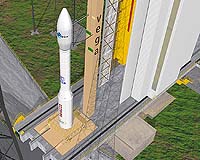 |
El Segundo CA (SPX) Jun 17, 2009 An improved second generation sound source used to simulate the intense noise generated by space rockets during launch has been developed by Wyle engineers. The Wyle Acoustic Source (WAS) 5000 is a high-frequency, high intensity sound source complementing the existing low-frequency WAS 3000 system, which has been regarded by experts as the "world's loudest speaker." Both are used to ensure that items such as satellites, solar panels and other space items can survive the heavy vibration caused by rocket motors. The WAS 5000 system is used in the company's acoustic test facility in El Segundo, Calif. where Wyle conducts close to 100 acoustic tests per year, geared primarily to the space industry but also to the qualification of aircraft components. Typical test items are satellite reflectors, solar panels and satellite components. "Pre-flight qualification testing of structures and components provides added assurance of meeting the high reliability requirements of aerospace vehicles," said Costa Glaretas, manager of Wyle's acoustic test operations in El Segundo. "Vibration caused by rocket noise during launch and flight operations is a major concern since it can damage satellites and other systems being sent into space. Since pressure fluctuation over the external skin is the principal source of vibration in modern flight vehicles, our acoustic test system offers a logical and effective simulation tool for reliability testing." Wyle serves a broad segment of the aerospace industry and has tested items for many programs with large visibility such as the Mars Rover, AMRAAM missile, DirectTV, XM Radio and a host of commercial satellite vendors. The WAS 5000 acoustic transducer is an electro-pneumatic noise source rated at 10 kW output over a frequency range of 25 to 5,000 Hz. Together with the WAS 3000, it can reproduce precise sine wave, random noise and sine-random combinations, and duplicate the sound profile of any rocket launch or aircraft environment. In reverberent chambers, the units can generate overall sound pressure levels up to 160 dB. Higher sound pressure levels can be attained in very small volume enclosures, or by using multiple modulators. In addition to being used in Wyle's acoustic test facility, the WAS 5000 is marketed to acoustic test companies and government agencies for domestic and international aerospace test facilities. Wyle has already taken an order for two WAS 5000 units for an international customer. Wyle has a long tradition in high intensity noise testing and facility design. In the late 1960s the company developed the WAS 3000, followed in 1997 by the Wyle Acoustic Control System, an acoustic control system specifically designed for acoustic test facilities. It has been recognized as the best system of its kind and 20 such systems have been sold to acoustic test laboratories the world over. With the addition of the WAS 5000, Wyle offers a complete complement of building blocks for design and operation of acoustic test facilities. These capabilities consolidate Wyle's leadership in the design and operation of acoustic test facilities Share This Article With Planet Earth
Related Links Wyle Rocket Science News at Space-Travel.Com
 Delays seen for Soyuz, Vega launches at Europe's space base
Delays seen for Soyuz, Vega launches at Europe's space baseLe Bourget, France (AFP) June 15, 2009 The first launches by the veteran Russian rocket Soyuz and a new light rocket called Vega from Europe's space base will be postponed to 2010, the European Space Agency (ESA) said on Monday. They had been scheduled to take place by the end of the year. A workhorse of space, Soyuz is being added to ESA's launch pad at Kourou, French Guiana, to provide the agency with operational flexibilit ... read more |
|
| The content herein, unless otherwise known to be public domain, are Copyright 1995-2009 - SpaceDaily. AFP and UPI Wire Stories are copyright Agence France-Presse and United Press International. ESA Portal Reports are copyright European Space Agency. All NASA sourced material is public domain. Additional copyrights may apply in whole or part to other bona fide parties. Advertising does not imply endorsement,agreement or approval of any opinions, statements or information provided by SpaceDaily on any Web page published or hosted by SpaceDaily. Privacy Statement |